Selection of a Residual Current Protector for EV charging
From 2016 to 2020, the number of electric vehicles sales increased from 466,000 to over 2,008,000 worldwide, maintaining an annualized average growth rate of 46.6 percent over the past five years. The sales of electric vehicles in China have been growing rapidly since 2017, with an annualized growth rate of more than 80% from 2017 to 2018. the growth of the new energy vehicle market can not be separated from the construction of basic charging facilities. How to ensure the safety of electricity in the charging process, in particular, it is worth paying attention to prevent leakage current from harming life and property.
As the residual current protective devices (RCD) is widely used in low-voltage distribution system to prevent electric shock accidents, leakage damage of electrical equipment and fire caused by electrical leakage. RCD is widely used as a basic electrical protection device in the field of electric vehicle charging application (IC-CPD and AC Charger/Wall-box).
There are four charging modes for electric vehicles shown in figure 1, which are clearly explained in IEC 61851-1-2017.
Mode 1, charging connection cables are used to connect electric vehicles with AC electrical grid,and residual current protection mainly relies on residual current protection devices (RCD) in building distribution boxes. since it can not be guaranteed that all existing building devices are equipped with RCD, this method is very dangerous and has been banned;
Mode 2, an on-cable control protection device (IC-CPD) is installed on the charging connection cable, and the IC-CPD has the residual current detection and protection function;
Mode 3 (AC Charger/ Wall-Box) ,used a AC power supply equipment connect to the electric vehicle directly with the AC power grid, and the control guidance device is installed on the special power supply equipment.
Mode 4 ( DC Charger Station), when electric vehicles are connected to AC or DC power grids, DC power supply devices with control guidance function are used. But we mainly discuss the selection of residual current protectors in mode 2 and mode 3 charging.The DC charger is not a topic in this article.
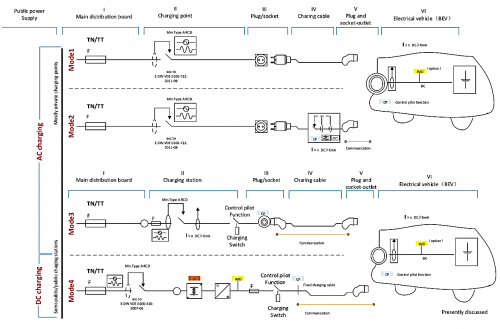
Figure 1. Four charging modes for electric vehicles
According to IEC 61851, it is clearly stipulated that the residual current protection in AC charging equipment shall adopt type B or type A + 6mA smooth DC RCD, which meets the requirements of IEC 60755-2017. Figure 2 shows the schematic diagram of mode 3 charge control guidance circuit, and a leakage current protector is installed inside the power supply equipment.
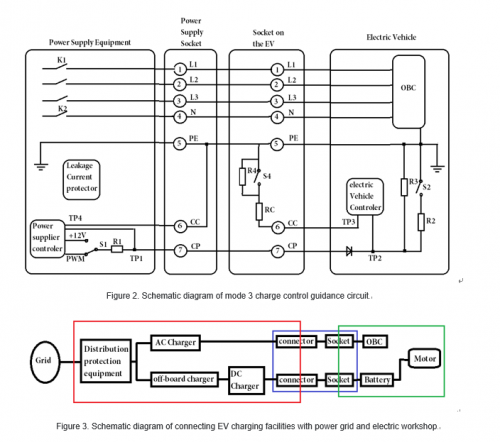
In IEC62752 < In-cable Control and protection device for mode 2 charging of electric road Vehicles ( IC-CPD)>
A smooth DC 6mA or a Type-B Leakage current detection is required in the IC-CPD application.
In IEC62955, A smooth DC 6mA or a Type-B Leakage current detection is required in the AC Charger/Wall-box application.
Why a type B or a smooth DC 6mA residual current protector been required?
Let’s do some basic analyze about the type of residual current that can be generated during charging.
As shown in Figure 3, during the charging process using the AC charger, the AC charger and the vehicle coupler are connected to the public grid. If insulation damage occurs when charging, power-frequency AC leakage current may occur. In electric vehicles, the possible leakage current mainly comes from the on-board charger (OBC). the general topology of the AC charger is mainly included in AC/DC and DC/DC. The following figure 4 shows the main circuit diagram of a common vehicle-mounted charger.
The AC/DC part of the single-phase input AC power is filtered by EMI first. Then, under the action of the Boost type APFC circuit, the AC power from 85 V to 265V is rectified into a stable output DC voltage of 400V, and provides the DC input for the rear stage. The DC/DC part adopts the phase shift full bridge LLC main circuit to convert the DC voltage of 400V into an acceptable voltage of the battery. When the insulation between the circuit board and the device housing is damaged, a pulsating DC residual current may be generated in the rectifier section, and a DC residual current with a small ripple coefficient may be generated in Boost type APFC circuits. Here, Bender’s diagram is used to explain in detail the generation and harm of DC residual current.
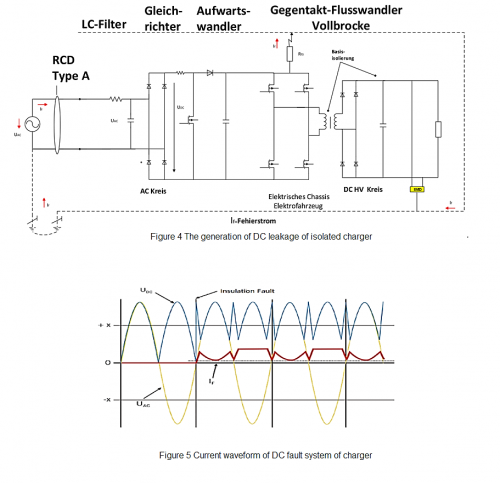
It can be seen from the figure 6 that DC leakage current may occur in DC/DC partial push-pull full-bridge converter. In the TN form of power supply, the metal shell of the equipment is connected to the working neutral line. DC leakage will be fed back to the charging line through the vehicle body and PE line, affecting the current waveform of the whole system. Through the simulation of the equivalent circuit, it is found that the current waveform of the whole system will change, as shown in the figure 5.
As we can see, DC leakage current at the back end also affects the front circuit, and the pulsating DC waveform after rectification will be distorted and spike, which will interfere with the back-end circuit step by step, affecting the charging effect and even affecting the battery life. On the other hand, due to the existence of TN system, this kind of fault will not form a large voltage in the vehicle body, which is less harmful to human body. However, if the grounding line of the connection system is missing or the PE line is disconnected, this part of voltage will harm human body. In fact, in many places, especially in rural areas, there are problems in the connection of PE line ground wire. The existing type A RCD can only detect the pulsating DC leakage current without being disturbed by the DC 6mA current, but cannot detect the pure DC leakage current and disconnect the protection. When the DC leakage current is more than 6 mA, due to the DC residual current will cause core magnetization in advance, make tripping value deviation, lead to type A RCD can’t normal movement. Therefore, type B RCD or A+6 protection must be used!
Various leakage current types
1)Type AC: Refers to the residual current waveform detection of pure AC, which is common for power frequency AC leakage. The waveform is relatively single and the leakage protection level is relatively low
2) Type A: the detection of pulsating AC and pulsating DC waveforms is added on the basis of AC type, and the leakage current protection level is relatively high
3) Type B: on the basis of type A, the detection of smooth DC, intermittent DC, high frequency 1kHz and various composite waveforms is added, which is a higher requirement for leakage protection. It is widely and mandatory to be used in electric vehicle charging applications.
Why a DC 6mA or a Type been required in IC-CPD and AC Charger/Wall-Box application?
The existing type A RCD can only in the detection of pulsating dc leakage from 6 mA dc current interference, and can’t detect dc leakage and disconnect protection, when DC leakage is more than 6 mA, due to the DC residual current will cause core magnetization in advance, make tripping value deviation, lead to type A RCD can’t normal movement. Therefore, type B RCD or A+6mA protection must be used!
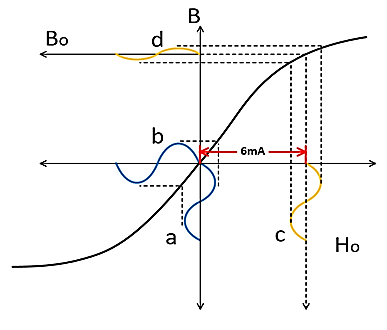
Figure 6. Type A RCD change in trip characteristics for >=6mA DC fault current
In the foreseeable future, with the electric vehicles into thousands of households, the EV charging will become an essential part of people’s life. Therefore, the replacement of the residual current protection in the EV charging is very necessary. Only a safe electricity environment can let everyone rest assured to enjoy the convenience of electric vehicles.
Magtron – All type Current Sensitive Residual Current monitoring Unit (RCMU Series Sensor) developed for EV-Charging Providing all-current sensitivity. The sensor can trigger an automatic shut-off (Trip) signal in case of hazardous electrical faults (DC and AC) according to IEC 62752 or IEC 62955. are widely used in electric vehicles charging systems — IC-CPD and AC Charger/Wall-Box application.
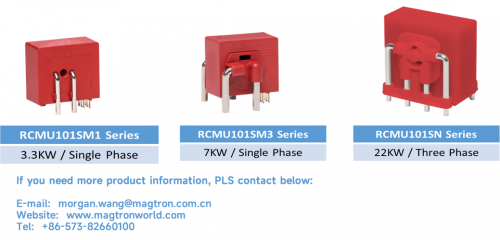
Figure 7. Magtron Series leakage current sensors for IC-CPD and AC Charger/Wall-Box
Benefits:
Protects against hazardous situations with fault currents, Preserving RCCB type A from saturation in case a smooth DC component in the circuit
Small volume and footprint for integration into compact IC-CPD and AC Charging Wall-box and Charging Piles
Robust mechanical and electrical design suitable for harsh environmental conditions
Electrical safety at low cost (compared to TYPE B RCCB)
Integrated self-check functions
Applications (EV Charging Mode 2 and Mode 3)
IC-CPD in charging Cables for electric vehicles (EV) and plug-in hybrid electric vehicles (PHEV).
AC Charging Wall-box for EV and PHEV.
AC Charging piles for EV and PHEV
Certification
TUV SUV Mark: B 1135980001
TUV Rheinland: 505140000001
DEKRA Attestation Of Conformity: 6097030.01
Media Contact
Company Name: Magtron Intelligent Technology Co.,Ltd
Contact Person: Morgan
Email: Send Email
Country: China
Website: www.magtronworld.com


